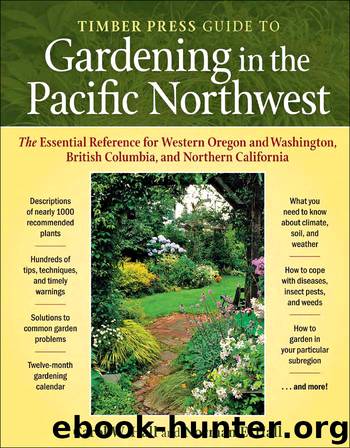Timber Press Guide to Gardening in the Pacific Northwest by Carol W. Hall & Norman E. Hall

Author:Carol W. Hall & Norman E. Hall
Language: eng
Format: epub
Publisher: Timber Press
Published: 2008-06-24T16:00:00+00:00
Lonicera nitida ‘Baggesen’s Gold’
LONICERA NITIDA ‘BAGGESEN’S GOLD’ (BAGGESEN’S GOLD BOX HONEYSUCKLE)
Origin: Sport of species native to China
Hardiness zones: 7 to 9
Size: 3 ft. (0.9 m) high and wide
Season of interest: Year-round
Exposure: Cool sun to light shade
Soil preference: Fertile; moisture-retentive but well drained
Water needs: Low
Maintenance needs: Low to moderate
Subregions best suited: All
Possible problems: None serious
Evergreen. This unassuming small shrub is a real sweetheart, welcome to add its bright but unobtrusive color and intricate texture to virtually any landscaping situation except hot, dry sun. New growth is an especially attractive buttery yellow; unlike many golden-foliaged shrubs, it remains true deep yellow in winter. It’s particularly effective with heaths and heathers, dwarf conifers, and hebes; it can also be used as a low hedge.
Its stiff stems covered with very small shiny leaves (nitida means “shining”) grow at seemingly random rates, giving the shrub a slightly tousled, pleasingly informal outline. Although it does need yearly pruning to keep long shoots from getting out of hand, its upkeep is nowhere near that of the plain green species, which grows so rampantly it needs pruning two or three times yearly. Shearing does it no harm—it will stubbornly revert to its normal irregular outline—but a lighter touch is more in keeping with its relaxed character.
Its one fault is that like the species, its lowest branches tend to root where they touch ground, sending up very vigorous suckers that can spoil its shape. It’s a good idea to check around the base for suckers during its annual haircut; these can be pulled up and cut off or transplanted elsewhere.
Cool sun brings out the brightest foliage color, but leaves will burn in intense or very hot sun. Established plants are reasonably drought tolerant in cool conditions, but cannot take extended drought or drought combined with high heat. It handles our wet winters with ease (anything short of waterlogged soil) and is an excellent choice for coastal areas, since it takes wind and even salt spray in stride.
Download
This site does not store any files on its server. We only index and link to content provided by other sites. Please contact the content providers to delete copyright contents if any and email us, we'll remove relevant links or contents immediately.
Turbulence by E. J. Noyes(7918)
The Thirst by Nesbo Jo(6805)
Gerald's Game by Stephen King(4554)
Be in a Treehouse by Pete Nelson(3921)
Marijuana Grower's Handbook by Ed Rosenthal(3605)
The Sprouting Book by Ann Wigmore(3529)
The Red Files by Lee Winter(3356)
The Remains of the Day by Kazuo Ishiguro(3278)
Sharp Objects: A Novel by Gillian Flynn(2939)
Christian (The Protectors Book 1) by L. Ann Marie(2644)
Organic Mushroom Farming and Mycoremediation by Tradd Cotter(2615)
The Culinary Herbal by Susan Belsinger(2419)
Stone Building by Kevin Gardner(2336)
The Starter Garden Handbook by Alice Mary Alvrez(2269)
Lilac Girls by Martha Hall Kelly(2243)
The Unlikely Pilgrimage of Harold Fry by Rachel Joyce(2202)
The Lean Farm Guide to Growing Vegetables: More In-Depth Lean Techniques for Efficient Organic Production by Ben Hartman(2082)
Urban Farming by Thomas Fox(2054)
Backyard Woodland by Josh VanBrakle(1879)
